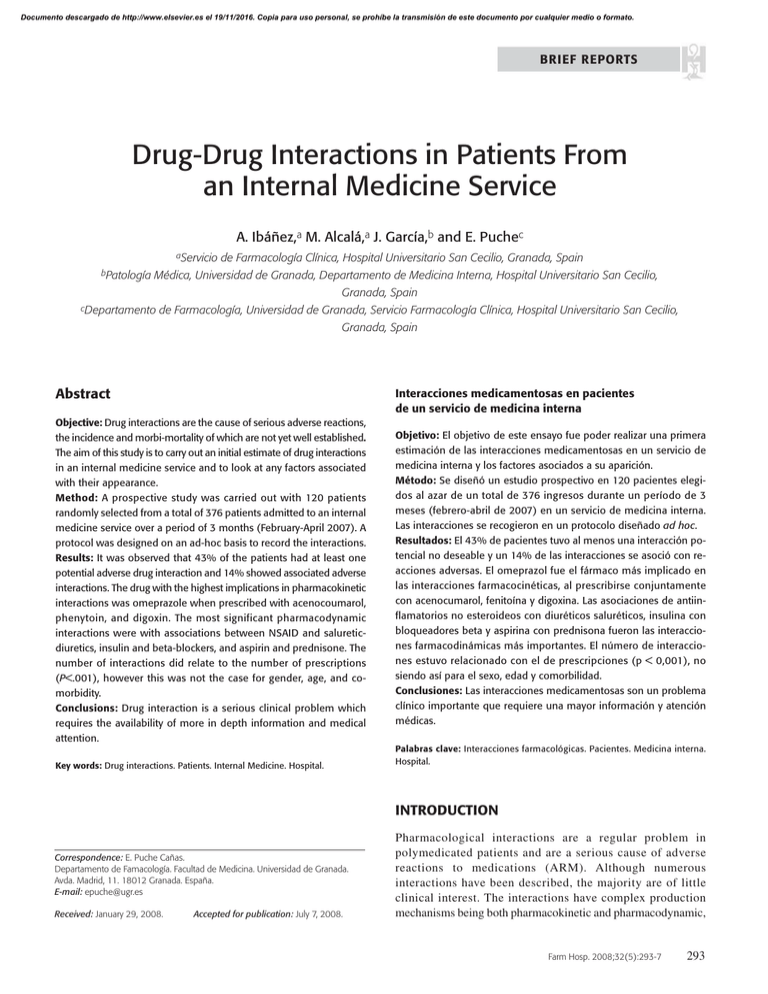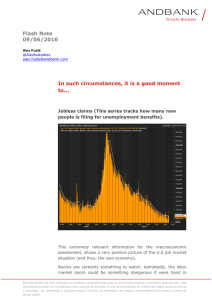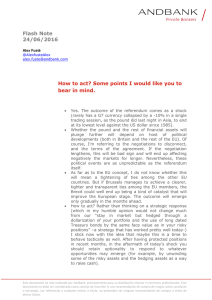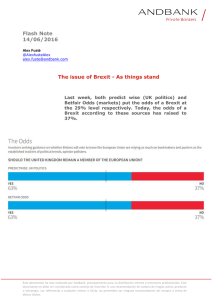Drug-Drug Interactions in Patients From an Internal
Anuncio

Documento descargado de http://www.elsevier.es el 19/11/2016. Copia para uso personal, se prohíbe la transmisión de este documento por cualquier medio o formato. BRIEF REPORTS Drug-Drug Interactions in Patients From an Internal Medicine Service A. Ibáñez,a M. Alcalá,a J. García,b and E. Puchec aServicio bPatología de Farmacología Clínica, Hospital Universitario San Cecilio, Granada, Spain Médica, Universidad de Granada, Departamento de Medicina Interna, Hospital Universitario San Cecilio, Granada, Spain cDepartamento de Farmacología, Universidad de Granada, Servicio Farmacología Clínica, Hospital Universitario San Cecilio, Granada, Spain Abstract Interacciones medicamentosas en pacientes de un servicio de medicina interna Objective: Drug interactions are the cause of serious adverse reactions, the incidence and morbi-mortality of which are not yet well established. The aim of this study is to carry out an initial estimate of drug interactions in an internal medicine service and to look at any factors associated with their appearance. Method: A prospective study was carried out with 120 patients randomly selected from a total of 376 patients admitted to an internal medicine service over a period of 3 months (February-April 2007). A protocol was designed on an ad-hoc basis to record the interactions. Results: It was observed that 43% of the patients had at least one potential adverse drug interaction and 14% showed associated adverse interactions. The drug with the highest implications in pharmacokinetic interactions was omeprazole when prescribed with acenocoumarol, phenytoin, and digoxin. The most significant pharmacodynamic interactions were with associations between NSAID and salureticdiuretics, insulin and beta-blockers, and aspirin and prednisone. The number of interactions did relate to the number of prescriptions (P<.001), however this was not the case for gender, age, and comorbidity. Conclusions: Drug interaction is a serious clinical problem which requires the availability of more in depth information and medical attention. Key words: Drug interactions. Patients. Internal Medicine. Hospital. Objetivo: El objetivo de este ensayo fue poder realizar una primera estimación de las interacciones medicamentosas en un servicio de medicina interna y los factores asociados a su aparición. Método: Se diseñó un estudio prospectivo en 120 pacientes elegidos al azar de un total de 376 ingresos durante un período de 3 meses (febrero-abril de 2007) en un servicio de medicina interna. Las interacciones se recogieron en un protocolo diseñado ad hoc. Resultados: El 43% de pacientes tuvo al menos una interacción potencial no deseable y un 14% de las interacciones se asoció con reacciones adversas. El omeprazol fue el fármaco más implicado en las interacciones farmacocinéticas, al prescribirse conjuntamente con acenocumarol, fenitoína y digoxina. Las asociaciones de antiinflamatorios no esteroideos con diuréticos saluréticos, insulina con bloqueadores beta y aspirina con prednisona fueron las interacciones farmacodinámicas más importantes. El número de interacciones estuvo relacionado con el de prescripciones (p < 0,001), no siendo así para el sexo, edad y comorbilidad. Conclusiones: Las interacciones medicamentosas son un problema clínico importante que requiere una mayor información y atención médicas. Palabras clave: Interacciones farmacológicas. Pacientes. Medicina interna. Hospital. INTRODUCTION Correspondence: E. Puche Cañas. Departamento de Famacología. Facultad de Medicina. Universidad de Granada. Avda. Madrid, 11. 18012 Granada. España. E-mail: [email protected] Received: January 29, 2008. Accepted for publication: July 7, 2008. Pharmacological interactions are a regular problem in polymedicated patients and are a serious cause of adverse reactions to medications (ARM). Although numerous interactions have been described, the majority are of little clinical interest. The interactions have complex production mechanisms being both pharmacokinetic and pharmacodynamic, Farm Hosp. 2008;32(5):293-7 293 Documento descargado de http://www.elsevier.es el 19/11/2016. Copia para uso personal, se prohíbe la transmisión de este documento por cualquier medio o formato. Ibáñez A et al. Drug-Drug Interactions in Patients From an Internal Medicine Service and tend to appear in a small group of medicines. Their incidence is highly variable. Various studies show interactions between 0.4% and 39% of medicated patients,1-6 and are found in 0.3%-8% of total prescriptions.1-4 Interactions are the source of an adverse reaction, generally a serious prognosis in 14%-25% of cases,4,7 and cause hospitalization in 1.6% of total patients hospitalized.8 Combined with the number of medications prescribed, advanced age is a factor associated with its occurrence, and the role of gender is debatable.9,10 Considering the issue’s clinical importance and the bibliography’s disparity of results regarding the prevalence of drug-drug interactions in patients, and on the other hand, the existence of suggestive data which directly involve interactions in a fifth of all ARM,4,7 a 3 month study was established with a sampling of patients from an internal medicine service. The objective was to assess the prevalence of potential drug-drug interactions in patients and factors associated with their occurrence, in order to contribute knowledge of this in our hospital. information collected previously could be debugged and included in the database. To not interfere with the study, experiment results were not communicated to unit doctors until being finalized. The Hansten and Horn criteria11 divide interactions into 5 categories: a) association always avoided; b) association allowed in special cases; c) association which requires treatment for reducing toxicity; d) association with risk of low toxicity; and e) association free of complications. The international classification CIE-10 was used for diagnoses, and for medications, ATC. Likewise, an ARM was defined as all signs or symptoms which appear in a patient treated with medications at therapeutic dosages (World Health Organization [WHO]); these were classified by A (frequent, dependent on the dosage); B (rare and independent from the dosage); and C (after continuous chronic administration). The degree of certainty of an ARM was classified as: certain, probable, possible, and doubtful, this based on the Karch y Lasagna algorithm; and the prognosis as: mild, moderate, serious, and lethal, according to the WHO criteria; the Charlson index was applied for comorbidity.12 Statistics METHOD For 3 months (March-May 2007) a prospective study was carried out on the prevalence of drug-drug interactions in a sample of patients admitted to the internal medicine service of the Hospital Universitario San Cecilio of Granada. They were randomly selected using a random number table, representative of patients admitted to the service and with sufficient size allowing for statistical analysis to be done on the results. Terminal and oncology patients were excluded from the study. A protocol was designed on an ad hoc basis to collect information mostly coming from the medical record, and at times from the doctor and nursing staff. This covered personal data such as age and sex; diagnosis at admission; dates of admission and discharge; pharmacological treatment received during hospitalization which included: number of medications, dosage/day, route of administration, time of prescription for each medication, and in the case of suspension, its cause, such as any medical incident which took place. Likewise, data on the possible occurrence of an ARM, the type, causality, diagnosis, and its prognosis were included. During the time of hospitalization, medical records were reviewed 3 days a week, and not always the same ones. They were reviewed independently by the same person, a scholarship holder in the sixth year of medicine previously trained for this. Once the protocol for collection of data was completed, the information was analyzed a posteriori by a clinical pharmacologist and an internist, who assessed possible interactions by applying the Hansten and Horn criteria. Furthermore, any sign or symptom which appeared in patients from the candidate study for an ARM was also analyzed by experts by applying causal and prognostic criteria. In this way, potential interactions could be collected to the extent as those expressed symptomatically (ARM), and the 294 Farm Hosp. 2008;32(5):293-7 Once the information was collected and previously debugged, it was entered into a database created to apply the corresponding statistical treatment, which consisted of descriptive statistics of results followed by the calculation of differences between distinct variables which were the object of study in 2 groups of patients, with and without interaction. For this, the Student t test was used for independent samples for the comparison of averages, and the Fisher exact test for proportions, and in both, the statistical significance limit was set at P<.05. The StatXact 7.0 statistical program was used. RESULTS Out of 376 patients admitted and registered during the study period, 120 were randomly selected (31%), with an age of 68 (18) years (average [standard deviation]). Fifty-seven percent were males and 64% older than 65 years (Table 1). Among the most frequent causes which prompted admission were pathologies related to the cardiocirculatory system, infectious intestinal disease, acute respiratory disease, and genitourinary disease, with an average of 1.2 (0.6) diagnoses per patient at admission. A total of 865 prescriptions were registered (7.2 per patient). In 51 patients (43%) a total of 120 potential interactions were found, and 51% fit into categories 2 and 3 of the Hansten and Horn classification, 2% in category 2, and 49% of the remaining in category 3. No cases of category 1 interaction were found. The drugs most involved in the appearance of interactions registered were, by order of importance: omeprazole, acenocoumarol, furosemide, digoxin, acetylsalicylic acid (ASA), benzodiazepines, phenytoin, cotrimoxazole, prednisone, amiodarone, non-steroidal anti-inflammatories (NSAI), Documento descargado de http://www.elsevier.es el 19/11/2016. Copia para uso personal, se prohíbe la transmisión de este documento por cualquier medio o formato. Ibáñez A et al. Drug-Drug Interactions in Patients From an Internal Medicine Service Table 1. General Characteristics for the 120 Patients Included in the Study Total admitted Number of patients selected Age, mean (SD), y Males >65 y Total prescriptions registered Prescriptions per patient, mean (SD) Patients with interaction Interactions per patient Drugs per patient, mean (SD) Diagnoses per patient, mean (SD) Number of patients with ARM 376 120 68 (18) 69 81 865 7.2 (2.1) 51/120 2.3% 6.7 (2.3) 1.3 (0.6) 17/120 31% 57% 64% 43% 14% ARM indicates adverse reactions to medications; SD, standard deviation. spironolactone, and angiotensin converting enzyme inhibitors (Table 2). Of all potential reactions collected, 14% were associated with an ARM, with 12% of adverse reactions being a serious prognosis. The drugs involved in the ARM were digoxin, carvedilol, furosemide, NSAI, acenocoumarol, clorazepate, and omeprazole, respectively; with symptoms of cardiac arrhythmia (bradycardia, auriculoventricular block, extrasystoles), arterial hypotension, appearance of oedemas, digestive haemorrhage, and behaviour disorders in patients, among others. In the study, 2 distinct responses were detected from 2 patients treated with clorazepate dipotassium + omeprazole; sedation occurred in one and in the other anxiety (Table 3). On the other hand, 2 ARM were detected in our study caused by an interaction with a serious prognosis, classified as type A and certain. One occurred in a male of 80 years diagnosed with symptoms of arthritis/arthrosis treated with prednisone, ASA, and omeprazole. He presented with an upper digestive haemorrhage with hemodynamic consequences, requiring specific treatment. The other one was in a woman of 73 years with congestive cardiac insufficiency decompensated in treatment with digoxin y furosemide, who presented with symptoms of bradycardia and second degree AV block accompanied by isolated ventricular extrasystoles; digoxinemia was at 2.3 ng/mL, potassium at 3.8 mEq/L, and blood creatinine at 1.6 mg/%. The patient improved after temporarily withdrawing digoxin and including a potassiumsparing diuretic. In both cases the dosage regimen of prescribed drugs for each patient was adjusted as recommended. Among the number of medications prescribed and the occurrence of interactions, a statistically significant association was found (texp=5.28; 118 g/L; P=.001). Regarding the relation of age in patients with and without pharmacological interaction, there was an increase of age in the group of patients with interactions which was not statistically significant (texp=0.60; 118 g/L; P=.547). There was no statistical significance for sex, for the number of those diagnosed at admission, or for comorbidity (Table 4). DISCUSSION The purpose of this study was to carry out a first estimate of drugdrug interactions which objectively allowed us to gauge the magnitude of the problem in our patients. Currently, in spite of efforts being taken, actual incidence of interactions in the population exposed to drugs is unknown, along with its morbidity and mortality. The majority of studies reviewed covering interactions in hospitalized patients were brief descriptions, only indicating percentages of interactions, both at admission and discharge of patients, and demonstrating the usefulness of a system for detecting Table 2. Examples of Potential Interactions Collected in Our Patients, Number of Patients With Interactions, Possible Inconveniences, Classification of the Interactions According to Hansten y Horn11 (Total = 120 Interactions) Drugs Digoxin + furosemide Digoxin + omeprazole Acenocoumarol + amiodarone Diazepam + omeprazole Acenocoumarol + diclofenac Captopril + insulin Acenocoumarol + carbamazepine Amiodarone + diltiazem Phenytoin + methadone Furosemide + NSAI Insulin + prednisone Insulin + beta-blockers Prednisone + aspirin Number 13 13 3 3 2 2 1 1 1 1 1 1 1 Possible Inconveniences Class Digitalis intoxication Digitalis intoxication Risk of bleeding Increase sedation Risk of bleeding (↑) Hypoglycaemic effect (↑) Anticoagulant effect (↓) Bradycardia Analgesic effect (↓) Diuretic effect (↓) Hypoglycaemic effect (↓) Response to stressa (↓) Risk of digestive haemorrhage (↑) 3 3 3 3 2 3 3 3 2 3 3 3 3 NSAI indicates non-steroidal anti-inflammatories. aStress induced by hypoglycaemia. Farm Hosp. 2008;32(5):293-7 295 Documento descargado de http://www.elsevier.es el 19/11/2016. Copia para uso personal, se prohíbe la transmisión de este documento por cualquier medio o formato. Ibáñez A et al. Drug-Drug Interactions in Patients From an Internal Medicine Service Table 3. Adverse Reactions Found, Drugs Involved, Number of Patients With Interactions, Prognosis, and Causality of These (Total = 17 Patients) Drugs Adverse Reaction ASA + prednisone Amiodarone + diltiazem Clorazepate + omeprazole Clorazepate + omeprazole Digoxin + furosemide Digoxin + carvedilol Digoxin + furosemide UDH Bradycardia Drowsiness Anxiety Hypotension Bradycardia Bradycardia and 2nd degree AV block Tachycardia Prostatism Oedemas High diastolic pressure Inappetence Inappetence Less analgesia Beta-methyl-digoxin + furosemide Beta-methyl-digoxin + furosemide Furosemide + indomethacin Furosemide + ibuprofen Omeprazole + acenocoumarol Omeprazole + digoxin Rifampicina + methadone Number Prognosis Causality 1 1 1 1 2 1 1 Serious Moderate Moderate Moderate Moderate Moderate Serious Certain Probable Probable Possible Probable Certain Certain 1 1 2 1 2 1 1 Moderate Moderate Moderate Moderate Mild Mild Moderate Probable Doubtful Possible Probable Doubtful Certain Probable ASA indicates acetylsalicylic acid; AV, auriculoventricular; UDH, upper digestive haemorrhage. aRifampicin + isoniazid + pyrazinamide. Table 4. Results Among Patients With and Without Drug-Drug Interactions, and Their Relation With Different Variables Studied Variable Age, mean (SD), y Number of drugs, mean (SD) Number of diagnoses per patient admitted, mean (SD) Comorbidity index Males Elders 65 years Without Interactions (n=68) With Interactions (n=52) P 68 (18) 6.2 (2.50) 1.4 (0.7) 5.6 (2.8) 39 42 70 (18) 8.6 (2.42) 1.2 (0.4) 6.8 (2.8) 30 39 NS .001 NS NS NS NS NS indicates not significant; SD, standard deviation. interactions by comparing the results obtained before and after informing the corresponding medical team.13-15 Furthermore, studies which analyze risk factors associated with interactions, and the presence of adverse reactions and their prognosis are few in the bibliography.14 Moreover, our study has the originality to provide information of great interest because of it contributing data, not only on the prevalence of interactions, but also on adverse reactions derived from the interactions themselves and their clinical assessment, and also provides data on risk factors associated with their appearance. Regarding the method used for detecting interactions, we consider it to be valid, as it was useful for finding possible potential interactions such as those associated with ARM. On the other hand, the percentage of drug-drug interactions found is comparable to those published by other authors on 296 Farm Hosp. 2008;32(5):293-7 hospitalized patients, including internal medicine, and to the drugs involved in their occurrence.5,6,13-15 Regarding factors which lead to the appearance of an interaction, it was found that only the number of prescriptions had a statistically significant relation, which coincides with results from the bibliography.1-9,14 In our results, it stood out that advanced age, where polymedication is usual, was not associated with the presence of interactions as described by other authors, 9,10 probably due to the patients of the study having such an advanced age range. Despite the fact that the age acted as a possible factor of confusion,16 it is, together with comorbidity, an element which should be taken into account in future studies which define its role in the origin of interactions. We are aware of our study’s limitations, overall because of the patients having such an advanced age which did not allow Documento descargado de http://www.elsevier.es el 19/11/2016. Copia para uso personal, se prohíbe la transmisión de este documento por cualquier medio o formato. Ibáñez A et al. Drug-Drug Interactions in Patients From an Internal Medicine Service conclusive results to be obtained regarding this. Likewise, we thought the size of the sample, although it was representative and sufficient for carrying out statistical analysis, was unable to detect a greater number of specific interactions or serious ARM’s caused by an interaction. We are currently designing a new study with an extended time period and increased sample sizes, which will allow for a response to all the questions posited, and confirm or not confirm the results obtained. Although more than 2000 drug-drug interactions have been identified, the majority are of little clinical interest.3,13 Nevertheless, a percentage of potential interactions of interest that we could estimate in view of our results in a third of total prescriptions and in 40% of patients is data which are comparable to those published.5,6,14,15 The given interactions took place with a reduced number of drugs with broad hospital use, these being omeprazole, oral anticoagulants, digoxin, furosemide, NSAI, analgesics, corticoids, and benzodiazepines, for the treatment of highly prevalent diseases and ailments in hospitalized patients, such as: arterial hypertension, cardiac insufficiency and arrhythmia, chronic obstructive pulmonary disease, thromboembolic disease, diabetes, arthrosis and arthritis, hyperacidity, pain, anxiety, and insomnia, among others. Guidelines and algorithms have been published recently for identifying interactions of clinical interest. While they may not cover all possible interactions, they do offer updated information allowing for previous knowledge, to avoid these, however possible, at the time of prescribing drugs.11,16 In hospitals, information technology is emerging as a tool for the communication and control of interactions by hospital pharmacy services, for which minimal investment and periodic updating of the database are required.1,6 We conclude stating that, in spite of the studies’ limitations, the results obtained are interesting for the health care professional, whether they be a doctor, pharmacist, or nurse, considering that an elevated proportion of patients are detected in internal medicine with at least one potential interaction, along with there being a high percentage of adverse reactions, some of them serious. All of this suggests that the problem of interactions is still not resolved, and that it could be undervalued clinically, the same occurring with ARM’s.17 More extensive studies are needed for defining the problem of potentially adverse interactions with a serious prognosis, along with greater attention and information on them in daily clinical practice. Acknowledgments To professor Luna del Castillo from the Department of Biostatistics of the Faculty of Medicine of Granada for statistical revision of results. To all doctors and nurses from the Internal Medicine Service of the Hospital de San Cecilio of Granada for their selfless collaboration. References 1. Crespo CA, Guerrero E, Sanmartín P, Castro B, Vila JL. Interacciones entre medicamentos: Detección precoz mediante un sistema computarizado. Farm Hosp. 1992;16 Suppl 01:38-44. 2. Comet D, Casajuana J, Bodas JM, Fuentes MA, Arnaiz JA, Núñez B, et al. Interacciones farmacológicas en la prescripción crónica. Aten Prim. 1997;20:71-4. 3. Bjerrum L, Andersen M, Petersen G, Kragstrup J. Exposure to potential drug interactions in primary health care. Scand J Prim Health Care. 2003;21:153-8. 4. Vargas E, Navarro MI, Laredo L, García-Arenillas M, García-Mateos M, Moreno A. Effect of drug interactions on the development of adverse drug reactions. Clin Drug Invest. 1997;13:282-9. 5. López P, Rodríguez C, Durán C, Tato F, Rodríguez I, Lado FL. Interacciones entre medicamentos prescritos al alta en un servicio de medicina interna. An Med Interna (Madrid). 2005;22:69-75. 6. Peral J, Lertxundi U, Martínez MJ, Mora O, Franco E, Gabilondo I. Evaluación prospectiva de interacciones entre medicamentos en pacientes ingresados mediante aplicación informática. Farm Hosp. 2007;31:93-100. 7. Guédon-Moreau L, Ducrocq D, Duc MF, Quieureux Y, Hote L, Deligne J, et al. Absolute contraindications in relation to potential drug intractions in outpatient prescriptions: analysis of the first five million prescriptions in 1999. Eur J Clin Pharmacol. 2003;59:689-95. 8. Jankel C, Fitterman L. Epidemiology of drug-drug interactions as a cause of hospital admissions. Drug Safety. 1993;09:51-9. 9. Seymur R, Routledge P. Important drug-drug interactions in the elderly. Drugs Aging. 1998;12:485-94. 10. Juurlink D, Mamdani M, Kopp A, Laupacis A, Redelmeier D. Drug-drug interactions among elderly patients hospitalized for drug toxicity. JAMA. 2003;289:1652-8. 11. Hansten P, Horn J. Drug interactions analysis and management. St. Louis, Missouri: Ed. Wolters Kluwer Health; 2006. 12. Charlson M, Szatrowski T, Peterson J, Gold J. Validation of a combined comorbidity index. J Clin Epidemiol 1994;47:1245-51. 13. Glintborg B, Andersen S, Dalhoff K. Drug-drug interactions among recently hospitalised patients-frequent but mostly clinically insignificant. Eur J Clin Pharmacol. 2005;61:675-81. 14. Cruciol JH, Thomson JC. Prevalence of potencial drug-drug interactions and its associated factors in a brazilian teaching hospital. J Pharm Pharmaceut Sci. 2006;9:427-33. 15. Vonbach P, Dubied A, Beer J, Krähenbühl S. Recognition and management of potential drug-drug interactions in patients on internal medicine wards. Eur J Clin Pharmacol. 2007;63:1075-83. 16. Morales-Olivas F, Estañ L. Interacciones medicamentosas. Nuevos aspectos. Med Clin (Barc). 2006;127:269-75. 17. Hazell L, Shakir S. Under reporting of adverse drug reactions: a systematic review. Drug Saf. 2006;29:385-96. Farm Hosp. 2008;32(5):293-7 297




